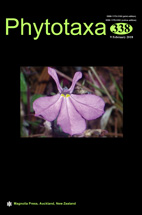Abstract
A new species, Camellia psilocarpa (Theaceae), from Guangdong Province, China, is described and illustrated. It is morphologically most similar to C. magnocarpa, from which it differs by having ovate-oblong leaves with apex caudate or long acuminate, bracteoles and sepals 10-12, grayish white velutinous outside, and especially smaller fruit. The morphological evidence shows that the new species is a member of Camellia sect. Camellia. Additionally, a molecular and phylogenetic analysis using two chloroplast DNA markers also gave support to its taxonomic position.

